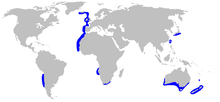The birdbeak dogfish (Deania calcea) is a dogfish shark of the family Centrophoridae found in the Pacific Ocean around Honshū, Japan, southern Australia, New Zealand, and Chile, and in the Atlantic Ocean from Iceland south to the Cape of Good Hope.[2]
| Birdbeak dogfish | |
|---|---|
| Drawing by Bideault | |

| |
| Scientific classification | |
| Domain: | Eukaryota |
| Kingdom: | Animalia |
| Phylum: | Chordata |
| Class: | Chondrichthyes |
| Subclass: | Elasmobranchii |
| Subdivision: | Selachimorpha |
| Order: | Squaliformes |
| Family: | Centrophoridae |
| Genus: | Deania |
| Species: | D. calcea
|
| Binomial name | |
| Deania calcea (R. T. Lowe, 1839)
| |

| |
| Range of birdbeak dogfish (in blue) | |
The birdbeak dogfish has a very long, narrow snout, no anal fin, two long and low dorsal fins with grooved spines, small rectangular pectoral fins, and pitchfork-like denticles. It lives at depths between 73 and 1,450 m. It is ovoviviparous with up to 12 pups per litter. It eats bony fish and shrimp.[2]
In June 2018 the New Zealand Department of Conservation classified the birdbeak dogfish as "Not Threatened" under the New Zealand Threat Classification System.[3]
A study published in the Journal of the Marine Biological Association of the United Kingdom evaluated the reproductive strategy of the female deep-water shark birdbeak dogfish. This research article discovers that there is a close relationship that exists between Hg level of pregnant females and the Hg level of their embryos, which indicates that there is a transfer of mercury from maternal sources. Therefore, there is a matrophoric strategy for the birdbeak dogfish that are ovoviviparous.[4]
With the rise of fisheries, the birdbeak dogfish is being consumed at higher rates. It has been found to be a good source of minerals, such as potassium and sodium. However, there have been health risks associated with frequent consumption of female dogfish.[5]
References edit
- ^ Finucci, B.; Cheok, J.; Cotton, C.F.; Kulka, D.W.; Neat, F.C.; Pacoureau, N.; Rigby, C.L.; Tanaka, S.; Walker, T.I. (2020). "Deania calcea". IUCN Red List of Threatened Species. 2020: e.T41798A68619155. doi:10.2305/IUCN.UK.2020-3.RLTS.T41798A68619155.en. Retrieved 19 November 2021.
- ^ a b Carpenter, Kent E.; Luna, Susan M. (2019). "Deania calcea (Lowe, 1839) Birdbeak dogfish". Fishbase. Retrieved 19 January 2019.
- ^ Duffy, Clinton A. J.; Francis, Malcolm; Dunn, M. R.; Finucci, Brit; Ford, Richard; Hitchmough, Rod; Rolfe, Jeremy (2018). Conservation status of New Zealand chondrichthyans (chimaeras, sharks and rays), 2016 (PDF). Wellington, New Zealand: Department of Conservation. p. 10. ISBN 9781988514628. OCLC 1042901090.
- ^ Paiva, R., Neves, A., Sequeira, V., Nunes, M., Gordo, L., & Bandarra, N. (2012). "Reproductive strategy of the female deep-water shark birdbeak dogfish, Deania calcea: Lecithotrophy or matrotrophy?" Journal of the Marine Biological Association of the United Kingdom, 92(2), 387-394. doi:10.1017/S0025315411001743
- ^ Barros Paiva, Rafaela; Neves, Ana; Sequeira, Vera; Cardoso, Carlos; Bandarra, Narcisa; Serrano Gordo, Leonel; Leonor Nunes, Maria (2012-06-08). "Risks and benefits' consumption of birdbeak dogfish Deania calcea". British Food Journal. 114 (6): 826–839. doi:10.1108/00070701211234354. ISSN 0007-070X.
